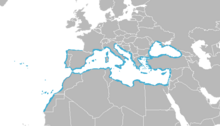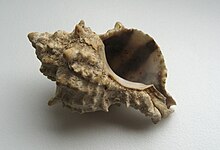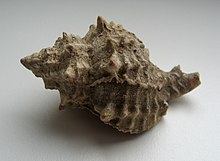Blunt spiny snail
| Blunt spiny snail | ||||||||||||
|---|---|---|---|---|---|---|---|---|---|---|---|---|
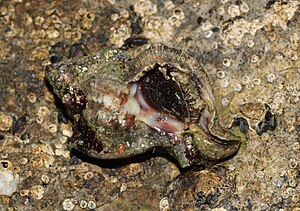
Housing of Hexaplex trunculus , closed with operculum |
||||||||||||
| Systematics | ||||||||||||
|
||||||||||||
| Scientific name | ||||||||||||
| Hexaplex trunculus | ||||||||||||
| ( Linnaeus , 1758) |
The blunt prickly snail or blunt prickly snail ( Hexaplex trunculus ), like some related species also called purple snail , is a snail from the family of prickly pods (genus Hexaplex ), which is widespread in the Mediterranean and the Eastern Atlantic . It feeds on mollusks , sea urchins , barnacles and polychaetes .
features
The broadly conical, forward more or less prickly snail shell of Hexaplex trunculus has a bulbous body, a protruding thread with seven whorls, six rows of bulges and a blunt bifurcated siphon canal. The whorls are angular and crowned with bumps on the edge. In adult snails, the shell reaches a length of 4 to 10 cm. The house is typically banded in white and brown, but the colors vary. The operculum is horny.
distribution
The blunt spiny snail occurs in the Mediterranean Sea and on the Atlantic coasts of Europe and Africa , especially off Spain , Portugal , Morocco , the Canary Islands and the Azores .
habitat
The blunt spiny snail lives mainly in the area below the intertidal zone.
Life cycle
Like other spiny snails, Hexaplex trunculus is separate sexes. The male mates with the female with his penis . According to studies in Portugal , the female attaches up to 200 or more tongue-shaped, approximately 5.5 mm long, 4.7 mm wide and 2.6 mm thick egg capsules per clutch to the solid ground. One egg capsule contains around 700 spherical eggs with a diameter of around 240 µm, enveloped in a thin yolk membrane, some of which serve as food eggs. Community clutches are formed that offer protection from predators. The development of the Veliger , which moves by flicking the eyelashes but cannot swim actively, takes place entirely in the egg capsules. After about a month, finished snails slip out of the capsules, whose shells are about 1.6 mm long with 1.5 to 2.5 whorls. In the first few weeks they do not eat anything, but probably live on yolk reserves. A phase of widespread cannibalism follows . After about a month the young animals begin to pierce and eat small mussels. In the first few months, they grow about 2.5 mm per month.
food
Hexaplex trunculus eats shellfish (eg. As mussels and oysters ), snails ( limpets ), sea urchins , barnacles ( barnacles ), bryozoans and tube worms . Also conspecifics are sometimes eaten. The shell of the prey is either broken open with the edge of the housing or drilled open with the radula and then the proboscis of the snail is guided through the hole to the meat of the victim. The blunt spiny snail has a significant influence on the population dynamics of prey species, such as the stone sea urchin in the area of the Medas Islands off Catalonia . The snail also eats carrion , which is why dead fish are used as bait to catch snails.
Importance to humans
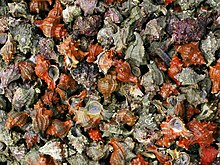
Hexaplex trunculus , for a long time under the original name Murex trunculus by Carl von Linné , later known under the synonym Trunculariopsis trunculus , forms a milky secretion in your hypobranchial gland for defense, which turns indigo blue when exposed to light. This was already used by the Minoans and later the Phoenicians as a purple-blue dye ( purple ).
The meat of the stump snail is particularly eaten in Portugal.
Individual evidence
- ↑ a b C. Brüggemann: The natural history in faithful illustrations and with a detailed description of the same. Eduard Eisenach publisher, Leipzig 1838. The molluscs. P. 71. The blunt prickly snail. Murex Trunculus L.
- ↑ Carolus Linnaeus : Systema Naturae. 10th edition. Lars Salvius, Stockholm 1758, pp. 747: 446. Murex Trunculus.
- ↑ R. Houart, p Gofas: Hexaplex trunculus (Linnaeus, 1758). In: P. Bouchet, S. Gofas, G. Rosenberg: World Marine Mollusca database. World Register of Marine Species , AphiaID: 140396.
- ^ S. Gofas, D. Moreno, C. Salas: Moluscos marinos de Andalucía. Volume I: Introducción general, clase Solenogastres, clase Claudofoveata, clase Polyplacophora y clase Gastropoda (Prosobranchia). Universidad de Málaga, Servicio de Publicaciones e Intercambio Científico, Málaga 2011, ISBN 978-84-9747-381-1 , p. 278.
- ↑ Paulo Da Conceição, Silva Vasconcelos: Spawning of Hexaplex (Trunculariopsis) trunculus (Gastropoda: Muricidae) in the laboratory: description of spawning behavior, egg masses, embryonic development, hatchling and juvenile growth rates. In: Biology, ecology and fishery of the Banded Murex, Hexaplex (Trunculariopsis) Trunculus, in the Ria Formosa Lagoon. (PDF; 6.9 MB). PhD thesis . Universidade do Algarve, Faro 2007, p. 147.
- ↑ Melita Peharda, Brian Morton: Experimental prey species preferences of Hexaplex trunculus (Gastropoda: Muricidae) and predator-prey interactions with the Black mussel Mytilus galloprovincialis (Bivalvia: Mytilidae) ( Memento of the original from February 25, 2017 in the Internet Archive ) Info: The archive link was inserted automatically and has not yet been checked. Please check the original and archive link according to the instructions and then remove this notice. . In: Marine Biology. March 2006, doi: 10.1007 / s00227-005-0148-5 .
- ↑ Enric Sala, Mikel Zabala: Fish predation and the structure of the sea urchin Paracentrotus lividus populations in the NW Mediterranean . In: Marine Ecology Progress Series. 140, 1996, pp. 71-81, doi: 10.3354 / meps140071 . Hexaplex trunculus is called here under the synonym Trunculariopsis trunculus .
- ↑ 6,6'-dibromoindigo. In: Paul Karrer : Textbook of Organic Chemistry. 8th edition. Georg Thieme Verlag, Leipzig 1942, p. 599.
literature
- GE Radwin, A. D'Attilio: Murex shells of the world. An illustrated guide to the Muricidae. Stanford Univ. Press, Stanford 1976, ISBN 0-8047-0897-5 .
